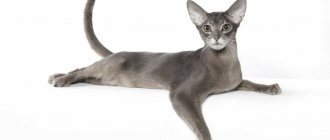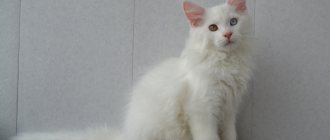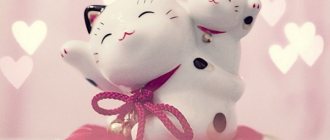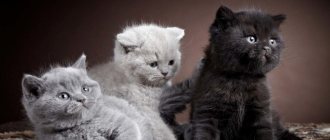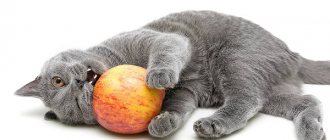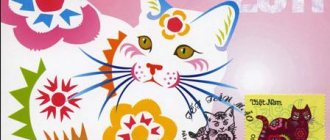The chocolate coloring of the native English breed is a unique phenomenon. It was one of the last to appear, and is allowed only in solid form, and traditionally is “capricious” - it tends to fade and change shade.
Outside of England and the USA, chocolate-colored Britons are rare, so they can confidently be called the “highlight” of the famous and ancient cat breed.
Who are the British
All representatives of the British breed, regardless of color, are distinguished by a rather massive and muscular physique. The body is compact, round and very harmoniously designed, with a wide, large chest and slightly short, strong legs. The average weight of males is 6–8 kg, but sometimes reaches 10 kg. Females are much smaller and lighter.
British cats have a massive build
The British have a large round head on a massive neck, with thick convex cheeks and a firm, pronounced chin. The ears are straight, medium-sized, and set wide apart. The eyes are large, round and well open. The tail is not distinguished by its outstanding size; at the base it is thickened to a rounded tip and slightly narrows. The coat is extremely thick and short with good quality undercoat and is very soft and pleasant to the touch.
Colors with white
The combination of any basic, patterned or tortoiseshell color with white is called the general name bicolor - these are colored spots without white fibers, with clear boundaries. There are several groups of this color:
- Bicolor – from 1/3 to 1/2 white – muzzle, chest, paws, belly. Colored - one or two ears, head, back, tail.
- Harlequin - only 5/6 white - collar, neck, chest, paws.
- Van – main color – white. Colored spots on the head, but the ears are white, colored tail, colored spots on the back are allowed.
- Tricolor, or calico, is a tortoiseshell (i.e., two-color) color with white.
- Mitted – is not recognized as a standard and is considered a flaw. There is little white, no more than 1/4, the head, neck, collar, belly and paws are white.
Now you know what the colors of British cats are. The table with photos helped us understand the variety of types and types of colors.
What is color and how are new colors developed?
The color of a cat refers to the color of the coat and the pattern on it. In general, domesticated cats are distinguished by an incredible variety of colors, unlike their wild relatives. There are not so many main genes responsible for the color of a mustachioed pet (solid color, lighteners, patterns, etc.), but their combination and various combinations create an endless number of options. Two genes are responsible for each trait, one of which is received from the mother, the other from the father. The task of a competent breeder is to correctly identify the necessary genes (dominant or recessive) and carefully select them to develop the desired shade.
What affects the cost of a British kitten
- The main reason influencing the price of a British kitten is its class. Show class cats are recognized as the most expensive and elite. For one small lump they ask for 15-30 thousand rubles, focusing on age, gender, pedigree, color.
- British breeding class kittens are sold a little cheaper. The price for these pets ranges from 9-15 thousand rubles.
- The most budget option will be the British pet class. A good kitten of this class costs between 3-6 thousand rubles. This cat will make a wonderful pet, but he will definitely need to be spayed/neutered.
- At a reasonable price, it is possible to purchase a purr without documents. Among their representatives there are British, which basically correspond to the breed standards, and those that only partially resemble them.
Not everyone knows how much you can buy a fold-eared kitten from a breeder. Many people want to save money, and in the hope that they will be lucky with a pet, they take a kitten from their hands on a website on the Internet, a bird market, or through an advertisement in a newspaper. However, some later regret it, because the kitten is growing, and it is not a fact that it will correspond to its breed. Flaws in the structure of the body, color, etc. are not excluded. But it is not yet known what kind of character the pet will have?!
History of the breeding of British chocolate
Breeders were not involved in the targeted breeding of brown fur in British cats . This color is not so common; it is characteristic of eastern representatives of the cat family (Burmese, Oriental, Siamese, etc.). The goal of the breeding work was to obtain color-point color in plush cats, for which they were crossed with color-point Persians.
The purpose of breeding the breeders was the color point color, and the chocolate color turned out to be an accident
The first chocolate Briton was born by chance in the 80s of the last century. But the color was so deep and luxurious that later breeders began to strive for a pure dark brown shade. British cats of this color are very popular.
Appearance Options
The Chocolate Briton has a strong build and a wide chest. Cats usually have short legs and a round head. It should be noted that the cat has fairly wide cheekbones. A kitten or cat's ears are straight. They are located quite widely.
The cat has eyes that are dark orange or copper in color. In this case, the more saturated the shade, the better. Purebred kittens have dark brown fur.
For a long period of time, chocolate-colored cats could only be found among representatives of oriental breeds. We are talking about Siamese, Oriental, Burmese cats. The British cat got its chocolate shade thanks to Persian Colorpoints of the corresponding color.
An interesting thing is that chocolate kittens have become more popular over time compared to their counterparts, thanks to which they acquire a beautiful shade.
Chocolate color standards for the British
There are very strict requirements for the chocolate color of British cats. According to the breed standard, the coat should be short and soft, but the structure should be elastic and not adhere to the animal’s body. A coat that is too soft and tight-fitting to the body or, conversely, a coat that is too harsh are considered serious faults. Due to the thick undercoat, the cat’s skin becomes plush, but excessive fluffiness is unacceptable.
The coat color should be a uniform deep and rich dark brown. Each hair is painted in one tone without play or flow along its entire length. The skin and undercoat are the same shade. The nose is only chocolate, but perhaps a little lighter than the main brown tone. The pads on the paws are also in dark chocolate tones. No stains, stripes, scorches or other effects are allowed by the standard. The animal must have an exceptionally even brown color, which is sometimes called chestnut, associating this color with the color of the ripe horse chestnut fruit. The saturation and density of the shade can vary from the color of a children's milk chocolate bar to a dark chocolate bar with a high cocoa content.
The coat of a Chocolate Briton should be colored evenly, without stripes, spots, marks, etc.
The color of expensive Havana cigars, which are also a rich dark brown, gave these Britons the nickname Havana.
The irises of the chocolate British are allowed only in yellow variations: from light copper to deep dark orange. Without the greenish rim often found in cats.
Chocolate Britons only have yellow eyes
Table: EMS encodings according to international standards WCF and FIFe
| Sign | Code | Name | |
| Breed | BRI | British shorthair | British Shorthair |
| Coat color | b | chocolate (brown, chestnut) | smooth brown or chestnut (chocolate) |
| Tail length | 54 | longy) | normal/long tail |
| Iris color | 62 | yellow, golden | yellow, golden, orange |
| Ears set | 71 | straight ears | straight - straight ears |
The darker and richer the chestnut color of the fur, as well as the brighter the eyes, the more valuable the cat is.
Upbringing
A person who wants to buy such a kitten after watching cute photos and videos needs to understand that from now on he will become the pet’s parent. Four-legged chocolate pets behave the same as representatives of other breeds. They are quite active, playful, affectionate, loving generous praise and care.
The British chocolate cat is inquisitive by nature. Because of the desire to know what is going on in the house, I am ready to sniff out and lick every centimeter of the apartment.
She is capable of charming anyone with just her appearance, even the most ardent opponent of pets, relying on her cute habits, habits and behavioral characteristics.
Anomalies and features inherent in the British chocolate color
The chocolate color is somewhat difficult to breed. Quite often, kittens are born in litters with residual stripes or spots, as well as with lightened undercoat. Which does not meet international standards, since the wool must be dyed evenly and uniformly. In addition, it is not immediately possible to understand exactly what shade of chocolate and what quality it will be.
At a certain period of time, the babies’ fur turns brown, acquiring an ugly yellowish-dirty hue. In most cases it goes away over time, but not always. Usually, only when the kitten reaches 12–15 months, and sometimes later (up to two years), does the complete development of color occur.
Chocolate British cat kittens do not immediately acquire their true color
Cat character: whims and requirements
The chocolate-colored Briton is independent, freedom-loving and willful. It is almost impossible to force a cat to do something against its will. However, if the owner finds an approach to him and raises him correctly, he will receive an obedient pet and a devoted friend. Despite their freedom-loving nature, animals are very dependent on their owners and require constant attention. If it is not enough, the cat may even become depressed. In addition, the pet adapts to the owner’s lifestyle. If he is at work, the animal is sleeping. As soon as the owner appears, the cat becomes active.
Despite their demands for the owner's attention, British chocolate kittens do not like to sit in their arms and are allowed to show interest in them only when they themselves want it. The owner of the animal should also remember that he does not respond to “kitty-kitty.” This important individual can only be called by name. The Briton is not inclined to meow, even when he is hungry. A British cat will simply sit next to the bowl and wait until he is fed.
Special rules for caring for British dogs with chocolate skins
Caring for chestnut-colored animals is no different and consists of the following actions:
- Proper nutrition (varied and balanced). Both feeding options are acceptable: ready-made factory feeds of at least super premium class (preferably holistic);
- natural food
- against fleas - shampoos, drops, collars, etc.
Any violations in the maintenance of the animal and health problems immediately reduce the quality of the British coat. The wool loses its natural shine and becomes dull.
Features of genetics and mating of British chocolate dogs
It is quite difficult to obtain a real, pronounced chocolate color from a cat's fur. In order for the offspring to have a dark brown coat, a necessary condition is the presence of a certain gene in both parents . In the gene set of a chocolate baby, it must be present in double size (from the mother and from the father). That is, both parents must have the same dark brown color.
The color of an animal's fur is determined by the presence of a coloring substance (pigment) in the hairs - melanin, which is present in the hair structure in the form of varying numbers of microscopic grains (granules) of different shapes and sizes.
Kittens are born chocolate only if both parents are the same color
There are two varieties of this pigment:
- eumelanin - gives black pigmentation;
- phaeomelanin - works in the yellow and red parts of the spectrum.
Strictly speaking, there is no specific gene responsible for chocolate. When the black pigment (B) is oxidized to red-yellow, a recessive oxidized gene is obtained that colors the coat brown (b). The kitten inherits one chromosome from both ancestors, so for the appearance of a chocolate baby, the combination bb must appear.
The intensity of the shade (dilution) depends on the D gene (Dilutor - diluent). In the dominant state of this gene, the granules of the coloring pigment in the hair are tightly packed, so the color will be thick and rich. If the form is recessive, then the color turns out faded and diluted. In British chestnuts this gene is dominant (D), so their color (like blacks) is hard and dense. The recessive position (d) gives a loose color (lilac or blue).
If one of the parents does not have chocolate coloring, but is a carrier of this gene, then only half of the kittens in the litter will turn out to be chocolate . Most often, a carrier female, who does not have the required brown tint, but has this gene in her gene set, is mated with a true 100% chocolate stud male. When crossing two carriers (very often a brother and sister), a maximum of only 25% of the offspring in the litter can be chocolate. There is also a certain risk in the fact that such kittens may not turn out at all.
One litter can have kittens of different colors
Thus, the basis of selection and the greatest value are not only the real chocolate Britons themselves, but also the carriers of this gene. Since the final color of the British with chestnut coat is formed very late, you have to wait a long time. Before this, young animals cannot be used for selection.
Chocolate Britons have retained the color point color in their gene set and are carriers of this gene, so they are often used for mating with cats of this color.
A good friend of mine has a gray British cat at home. She has no pedigree, as she was bought inexpensively from some distant relatives. A cat is bred every year with the same cat found through an advertisement. A stud cat of blue color and some very good blood. Few kittens are born, usually no more than 3–4. The colors vary; there are always blue and lilac kittens in the litter. But sometimes a chocolate baby is born, to the great joy of the owner. This suggests that both the cat and the cat have the chocolate gene, that is, they are its carriers.
Video: British chocolate kitten
Tabby
The patterned cats resemble wild ones in color. They have spots, stripes, rings on the body and paws and the obligatory letter "M" on the forehead. Tabby color also has several types:
- Spotted, spotted, or leopard print is the most common tabby. Cats of this color look like miniature leopards.
- Striped, mackerel, or tiger. Narrow frequent stripes should not be interrupted or intersect with each other. After a year, the brindle color may turn into leopard if the stripes begin to break up.
- The merle color is very impressive, bright and the most complex of the tabbies. The stripes on the back are straight, but on the sides they form clearly visible circles and rings.
- The ticked color stands apart - it has no pattern and looks like a plain one with “spraying”. Resembles shaded or veiled. Each hair has its own stripes.
Peculiarities of chocolate British participation in cat shows
If a British chocolate cat exactly meets all breed standards, is healthy and has no external physical defects, and also has the necessary documents (pedigree), then it can take part in any cat shows.
Preparations for exhibition events are carried out in advance:
- The animal is bathed (if the coat looks oily) with a special shampoo. It is recommended to use conditioner (same brand).
- Clean ears and eyes.
- Carefully trim the claws.
- Using a special brush and toothpaste, brush your pet’s teeth (2-3 days before the event).
To prevent the rich brown color from fading or fading, the animal should not be exposed to direct sunlight. Tinting and tinting wool is strictly prohibited.
The show animal must meet all breed standards
Individuals with the following deficiencies are subject to disqualification:
- white inclusions, stripes, spots or lighter undercoat (brownish or gray);
- eyes of an inappropriate shade or rim around the iris;
- not brown color of the nose and paw pads;
- excess or insufficient number of fingers;
- undershot or overshot (more than 2 mm);
- tail defects (bends, creases);
- the coat is too long or very fluffy.
Our neighbor has a black cat who leads a free lifestyle. He spends most of the warm season outside, free-ranging. He comes home only to eat. Since in the summer he is often exposed to the sun, his fur fades greatly and becomes an unsightly brownish-brown color. In winter, when it is frosty outside, he sits at home and after molting again becomes blue-black.
Brief description of British cats
The British Shorthair is a rather powerful-looking large cat with a wide chest, strong thick legs with rounded paws and a medium-length tail with a blunt tip. The head is relatively large and rounded, with a short muzzle, wide cheeks (most noticeable in mature males, which tend to develop prominent jaws) and huge round eyes, which are dark copper-orange in British Blues and in others cases vary in color depending on the coat. Their ears are large and set wide apart.
The British Blue variant can often be confused with the Gray Scottish Fold. However, in shorthairs the difference can be characterized by the presence of sharp triangular ears, while in Scottish cats they are soft and folded.
Scottish Fold cats
are slower to mature than most cat breeds, reaching full physical development at approximately three years of age.
Unusual among domestic cats, they are a noticeably sexually dimorphic breed, with males averaging 4.1–7.7 kg and females 3.2–5.4 kg.
Silver chinchilla
Blue color
Lilac color
Blue color
Bicolor
Blue color
The British Shorthair is one of the defining characteristics of the breed. It is very dense, but has no undercoat. Thus, the texture is soft rather than downy or fluffy, with a hard, "fresh" coat that visibly "breaks" throughout the cat's body as it moves.
British Blue is still the most familiar variety, however British Shorthairs have been sectioned into many other colors and patterns. Black, blue, white, red, cream, silver, gold and, more recently, the cinnamon (cinnamon) and fawn colors are accepted according to all official standards, either solid or colored, tabby, shaded and two-tone.
Golden chinchilla
Felinological associations GCCF, FIFe and TICA also accept the color chocolate and its diluted shade lilac, prohibited by the CFA standard. All colors and patterns also have tortoiseshell options.
Tabby patterns include the following varieties:
- Classic tabby;
- Tabby Mackerel;
- Spotted and tabby marked.
Non-tabby patterns include the types:
- Turtle cake;
- Two-tone bicolor;
- Two-tone with white;
- Smokey tuxedo;
- Color-point.
British Blue Cat
Temperamentally, this is a calm and dignified breed, not as active and playful as many others, but good-natured and devoted to their owners, which makes them favorite trainable pets.
They are generally safe around other pets and children, as they will tolerate a fair amount of physical interaction, but generally do not like to be picked up or carried. They require only minimal care and are easy to keep, however, they can be prone to obesity if care is not taken with diet.
The English Breed Committee considers the British Shorthair to be a long-lived cat with a life expectancy of 14-20 years. Data from veterinary clinics in England shows an average of 11.8 years. According to Swedish statistics, the average life expectancy of the breed is more than 12.5 years. 82% of British Shorthairs lived to 10 years or more, and 54% to 12.5 years or more.
Blue color
Although a condition such as hypertrophic cardiomyopathy (HCM) can be a problem in the breed. A study of its prevalence in Denmark involving more than 329 cats found that 20.4% of males and 2.1% of females had HCM. In addition, 6.4% of males and 3.5% of females were considered at risk. HCM testing of cats used for breeding is now mandatory for breeders organized under the authority of member Fife Denmark.
The breed is considered to be at high risk for polycystic kidney disease (PCD). The DNA testing laboratory noted a significant reduction in PKD mutations in the populations tested.
Golden British cats
